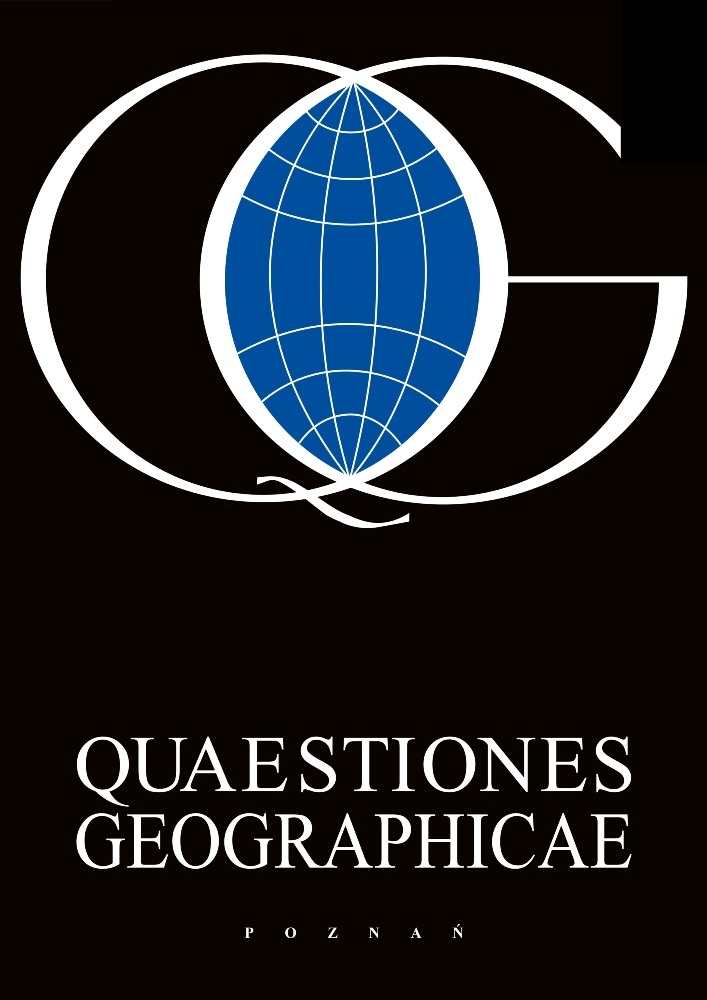Abstract
Hydrochemical investigations were carried out in the periglacial basin of Obruchev Glacier (Polar Urals, Russia) in order to provide a quantitative and qualitative comparison of dissolved solids yields during the ablation season with and without snow cover taking into account the mineral composition of rocks and deposits occurring in the studied area. The concentration of dissolved solids in the waters of the investigated basin is very low (about 7.0-8.9 μS cm-1). It is most of all due to harsh local climate conditions as well as the presence of minerals resistant to weathering in the parent material. Both factors contribute to the low rate of chemical weathering in the area. Results obtained indicate that a larger dissolved solids yield was transported during the period with snow cover (106 kg km-2 day-1, on average), than at the same time of the year but without snow cover (13 kg km-2 day-1, on average) indicating that melting snow is an important factor influencing the yield of dissolved solids in surface waters.
References
Beylich A., Sandberg O., Molau U. & Wache S., 2006. Intensity and spatio-temporal variability of fluvial sediment transfers in an Arctic-oceanic periglacial environment in northernmost Swedish Lapland (Latnjavagge catchment). Geomorphology 80(1-2): 114-130, DOI: https://www.doi.org/10.1016/j.geomorph.2005.09.014.
Beylich A. Kolstrup E. Thyrsted T. & Gintz D., 2004. Water chemistry and its diversity in relation to local factors in the Latnjavagge drainage basin, arctic-oceanic Swedish Lapland. Geomorphology 58 (1-4): 125-143, DOI: https://www.doi.org/10.1016/S0169-555X(03)00228-9.
Bolewski A., 1982. Mineralogia szczegółowa (Detailed Mineralogy). Wydawnictwa Geologiczne, Warszawa.
Brown G., 2002. Glacial meltwater hydrochemistry. Applied Geochemistry 17(7): 855-883, DOI: https://www.doi.org/10.1016/S0883-2927(01)00123-8.
Caine N., 1992. Spatial patterns of geochemical denudation rate in a Colorado Alpine Environment. In: J. C. Dixon, A. D. Abrahams (eds.), Periglacial Geomorphology Proceedings to the 22nd Annual Binghamton Symposium in Geomorphology, John Wiley and sons, Chichester: 63-88.
Caine, N., 1979. Rock weathering rates at the soil surface in an alpine environment. Catena 6(2): 131-144, DOI: https://www.doi.org/10.1016/0341-8162(79)90003-1.
Collins N., 1979. Hydrochemistry of meltwaters draining from an alpine glacier (Gornergletsher, Switzerland). Arctic and Alpine Research, 11(3): 307-324.
Darmody R. G., Thorn C. E., Harder R. L., Schlyter J. P. & Dixon J. C., 2000. Weathering implications of water chemistry in an arctic-alpine environment, northern Sweden. Geomorphology, 34(1-2): 89-100, DOI: https://www.doi.org/10.1016/S0169-555X(00)00002-7.
Dixon J. C., Thorn C. E. & Darmody R. G., 1984. Chemical weathering processes on the Vantage Peak Nunatak, Juneau Icefield, southern Alaska. Physical Geography, 5: 111-131.
Hodson A., Tranter M. & Vante G., 2000. Contemporary rates of chemical denudation and CO2 sequestration in glacier basins: an Arctic perspective. Earth Surface Processes and Landforms, 25: 1447-1471, DOI: https://www.doi.org/10.1002/1096.9837(200012)25:13<1447::AID-ESP156>3.0.CO; 2-9.
Hounslow A. W., 1995. Water Quality Data Analysis and Interpretation. Lewis Publisher, Los Angeles.
Kononov Y., Ananicheva, M. & Willis, I., 2005. High-resolution reconstruction of Polar Ural glaciers mass balance for the last millennium. Annals of Glaciology, 42: 163-170, DOI: https://www.doi.org/10.3189/172756405781812709.
Krawczyk W. & Pettersson L.-E. 2007. Chemical denudation rates and carbon dioxide drawdown in an ice-free polar karst catchment: Londonelva, Svalbard. Permafrost and Periglacial Processes 18(4): 337-350, DOI: https://www.doi.org/10.1002/ppp.599.
Lessovaia S. N. & Polekhovsky Yu., 2009. Mineralogical composition of shallow soils on basic and ultrabasic rocks of East Fennoscandia and of the Ural Mountains, Russia. Clays and Clay Minerals, 57(4): 476-485, DOI: https://www.doi.org/10.1346/CCMN.2009.0570408.
Mangerud J., Gosse J., Matiouchkov A. & Dolvik T., 2008. Glaciers in the Polar Urals, Russia, were not much larger during the Last Global Glacial Maximum than today. Quaternary Science Reviews, 27 (9-10): 1047-1057, DOI: https://www.doi.org/10.1016/j.quascirev.2008.01.015.
Rapp A., 1960. Recent development of mountain slopes in Karkevagge and surroundings, northern Scandinavia. Geografiska Annaler, 42: 71-200.
Stupnicka E., 1978. Zarys geologii regionalnej świata. Wydawnictwa Geologiczne, Warszawa.
Tranter M., Brown G. H., Hodson A. J. & Gurnell A. M. 1996: Hydrochemistry as an indicator of subglacial drainage system structure: A comparison of alpine and sub-polar environments. Hydrological Processes 10(4): 541-556, DOI: https://www.doi.org/10.1002/(SICI)1099-1085(199604)10:4<541::AID-HYP391>3.0.CO; 2-9.
Troitsky L. S., 1961. Some features of modern glaciation of Polar Urals. (Nekotoriye osobennosti sovremennogo oledeneniya Poliarnogo Urala). Glaciological Studies. (Gliatsiologicheskiye issledovaniya) 6: 70-85.
Tushinskiy G. K., 1963. Glaciers, snowfield, and avalanche of the Soviet Union. State Publishing House of Geographical Literature, Moscow.
Wadham J. L., Hodson A. J., Tranter M. & Dowdeswell J. A., 1998. The hydrochemistry of meltwaters draining a polythermal-based, high arctic glacier, south Svalbard: I. The ablation season. Hydrological Processes 12(12): 1825-1849, DOI: https://www.doi.org/10.1002/(SICI)1099-1085(19981015)12:12<1825::AID-HYP669>3.0.CO; 2-R.
Wadham J. L., Tranter M. & Dowdeswell J. A., 2000. Hydrochemistry of meltwaters draining a polythermal-based, high-arctic glacier, south Svalbard: II. winter and early spring. Hydrological Processes 14(10): 1767-1786, DOI: https://www.doi.org/10.1002/1099-1085(200007)14:10<1767::AID-HYP103>3.0.CO; 2-Q.
Wałach P., 2008. The daily air temperature course in the bottom of selected glacier cirques in the Polar Ural. Problemy Klimatologii Polarnej, 18: 171-180.
Wałach P. & Stachnik Ł., 2011. Wpływ warunków meteorologicznych na kształtowanie się odpływu i chemizmu wód w zlewni lodowca Obrucheva (Ural Polarny). Przegląd Geograficzny. (in review)
Voloshina A. P., 1987. Some totals of the mass balance studies of Polar Ural glaciers. Data of Glaciologic Studies 61: 44-51.
Zakharova E. A., Pokrovsky O. S., Dupré B., Gaillardet J. & Efimova L. E., 2007. Chemical weathering of silicate rocks in Karelia region and Kola peninsula, NW Russia: Assessing the effect of rock composition, wetlands and vegetation. Chemical Geology 242: 255-277, DOI: https://www.doi.org/10.1016/j.chemgeo.2007.03.018.
License
This content is open access.
